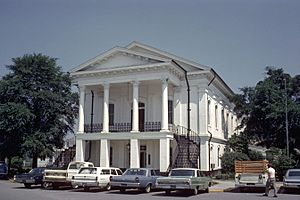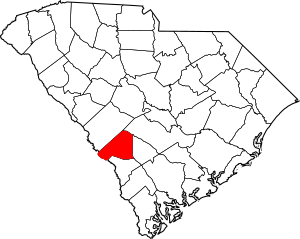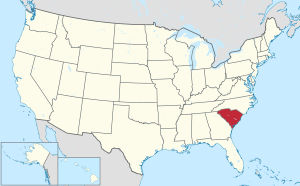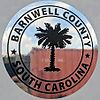Barnwell County, South Carolina facts for kids
Quick facts for kids
Barnwell County
|
|||
|---|---|---|---|

Barnwell County Courthouse
|
|||
|
|||

Location within the U.S. state of South Carolina
|
|||
 South Carolina's location within the U.S. |
|||
| Country | |||
| State | |||
| Founded | 1800 | ||
| Named for | John Barnwell | ||
| Seat | Barnwell | ||
| Largest community | Barnwell | ||
| Area | |||
| • Total | 557.26 sq mi (1,443.3 km2) | ||
| • Land | 548.38 sq mi (1,420.3 km2) | ||
| • Water | 8.88 sq mi (23.0 km2) 1.59% | ||
| Population
(2020)
|
|||
| • Total | 20,589 | ||
| • Estimate
(2023)
|
20,447 | ||
| • Density | 37.55/sq mi (14.50/km2) | ||
| Time zone | UTC−5 (Eastern) | ||
| • Summer (DST) | UTC−4 (EDT) | ||
| Congressional district | 2nd | ||
Barnwell County is a county in the U.S. state of South Carolina. As of the 2020 census, its population was 20,589. It is located in the Central Savannah River Area. Its county seat is Barnwell.
Contents
History
The Barnwell District was created in 1797 (effective in 1800) from the southwestern portion of the Orangeburg District, along the Savannah River. It was named after John Barnwell, a local figure in the Revolutionary War.
In 1868, under the South Carolina Constitution revised during Reconstruction, South Carolina districts became counties. The government was made more democratic, with county officials to be elected by male citizens at least 21 years old, rather than by the state legislature as done previously.
In 1871, the legislature took the northwestern portion of the county to form part of the new Aiken County, the only county organized during the Reconstruction era. In 1874, the border with Aiken County was slightly adjusted. Aiken and Barnwell, with nearly equal, populations of Black and white people, had extensive violence in the months before the 1874 and 1876 elections, as groups of paramilitary Red Shirts rode to disrupt Black Republican meetings and intimidate voters to suppress Black voting. More than 100 Black men were killed in Aiken County during the violence, especially at Ellenton, South Carolina.
In 1895, white Democrats in the state legislature passed a new constitution, disfranchising most Blacks for more than 60 years by raising barriers to voter registration.
In 1897, the eastern third of the county was taken to form the new Bamberg County. In 1919, most of the southern half of the county was taken to form most of the new Allendale County, thus reducing Barnwell County to its present size.
Geography
According to the U.S. Census Bureau, the county has a total area of 557.26 square miles (1,443.3 km2), of which 548.38 square miles (1,420.3 km2) is land and 8.88 square miles (23.0 km2) (1.59%) is water.
State and local protected areas/sites
- Banksia Hall
- Barnwell State Park
- Long Branch Bay Heritage Preserve
Major water bodies
- Georges Creek
- Par Pond
- Salkehatchie River
- Savannah River
- South Fork Edisto River
Adjacent counties
- Aiken County – north
- Bamberg County – east
- Orangeburg County – east
- Allendale County – southeast
- Burke County, Georgia – southwest
Major highways
 US 78
US 78
 US 78 Bus.
US 78 Bus. US 278
US 278 SC 3
SC 3 SC 37
SC 37 SC 39
SC 39 SC 64
SC 64 SC 70
SC 70 SC 125
SC 125 SC 300
SC 300 SC 304
SC 304
Major infrastructure
- Barnwell Regional Airport
- Savannah River Site (part)
Demographics
| Historical population | |||
|---|---|---|---|
| Census | Pop. | %± | |
| 1800 | 7,376 | — | |
| 1810 | 12,280 | 66.5% | |
| 1820 | 14,750 | 20.1% | |
| 1830 | 19,236 | 30.4% | |
| 1840 | 21,471 | 11.6% | |
| 1850 | 26,608 | 23.9% | |
| 1860 | 30,743 | 15.5% | |
| 1870 | 35,724 | 16.2% | |
| 1880 | 39,857 | 11.6% | |
| 1890 | 44,613 | 11.9% | |
| 1900 | 35,504 | −20.4% | |
| 1910 | 34,209 | −3.6% | |
| 1920 | 23,081 | −32.5% | |
| 1930 | 21,221 | −8.1% | |
| 1940 | 20,138 | −5.1% | |
| 1950 | 17,266 | −14.3% | |
| 1960 | 17,659 | 2.3% | |
| 1970 | 17,176 | −2.7% | |
| 1980 | 19,868 | 15.7% | |
| 1990 | 20,293 | 2.1% | |
| 2000 | 23,478 | 15.7% | |
| 2010 | 22,621 | −3.7% | |
| 2020 | 20,589 | −9.0% | |
| 2023 (est.) | 20,447 | −9.6% | |
| U.S. Decennial Census 1790–1960 1900–1990 1990–2000 2010 2020 |
|||
2020 census
| Race | Num. | Perc. |
|---|---|---|
| White (non-Hispanic) | 10,352 | 50.28% |
| Black or African American (non-Hispanic) | 8,785 | 42.67% |
| Native American | 61 | 0.3% |
| Asian | 161 | 0.78% |
| Pacific Islander | 14 | 0.07% |
| Other/Mixed | 696 | 3.38% |
| Hispanic or Latino | 520 | 2.53% |
As of the 2020 census, there were 20,589 people, 8,360 households, and 5,260 families residing in the county.
2010 census
At the 2010 census, there were 22,621 people, 8,937 households, and 6,055 families living in the county. The population density was 41.2 inhabitants per square mile (15.9/km2). There were 10,484 housing units at an average density of 19.1 units per square mile (7.4 units/km2). The racial makeup of the county was 52.6% white, 44.3% Black or African American, 0.6% Asian, 0.4% American Indian, 0.7% from other races, and 1.5% from two or more races. Those of Hispanic or Latino origin made up 1.8% of the population. In terms of ancestry, 11.5% were American, 5.7% were German, and 5.4% were English.
Of the 8,937 households, 34.0% had children under the age of 18 living with them, 41.8% were married couples living together, 20.8% had a female householder with no husband present, 32.2% were non-families, and 28.4% of all households were made up of individuals. The average household size was 2.50 and the average family size was 3.05. The median age was 38.8 years.
The median income for a household in the county was $33,816 and the median income for a family was $41,764. Males had a median income of $35,957 versus $30,291 for females. The per capita income for the county was $17,592. About 20.8% of families and 25.4% of the population were below the poverty line, including 39.6% of those under age 18 and 11.5% of those age 65 or over.
Economy
In 2022, Barnwell County's GDP was $556.3 million (approx. $27,018 per capita). In chained 2017 dollars, its real GDP was $448.3 million (approx. $21,774 per capita). From 2022 through 2024, the unemployment rate for the county has fluctuated from a high of 6.3% in January 2022 and a low of 3.2% in April 2023.
As of April 2024[update], Walmart is one of the largest employers in the county.
| Industry | Employment Counts | Employment Percentage (%) | Average Annual Wage ($) |
|---|---|---|---|
| Accommodation and Food Services | 372 | 7.8 | 16,900 |
| Administrative and Support and Waste Management and Remediation Services | 83 | 1.7 | 54,080 |
| Agriculture, Forestry, Fishing and Hunting | 68 | 1.4 | 39,884 |
| Construction | 172 | 3.6 | 62,972 |
| Educational Services | 613 | 12.8 | 41,392 |
| Finance and Insurance | 64 | 1.3 | 40,716 |
| Health Care and Social Assistance | 715 | 14.9 | 36,296 |
| Information | 9 | 0.2 | 32,188 |
| Manufacturing | 1,039 | 21.7 | 59,956 |
| Other Services (except Public Administration) | 161 | 3.4 | 36,348 |
| Professional, Scientific, and Technical Services | 108 | 2.3 | 50,024 |
| Public Administration | 422 | 8.8 | 38,948 |
| Retail Trade | 797 | 16.6 | 26,624 |
| Transportation and Warehousing | 134 | 2.8 | 57,512 |
| Wholesale Trade | 33 | 0.7 | 47,164 |
| Total | 4,790 | 100.0% | 41,546 |
Communities
City
- Barnwell (county seat and largest community)
Towns
Education
School districts in the county include:
- Barnwell School District 19
- Barnwell School District 29
- Barnwell School District 45
A portion is not in any school district, labeled by the 2010 U.S. Census as "School District Not Defined". This corresponds with the Savannah River Site.
Notable people
- James Brown (1933–2006), singer
- Rosa Louise Woodberry (1869–1932), journalist and school founder
- Sarah Lowe Twiggs (1839–1920), poet
See also
 In Spanish: Condado de Barnwell para niños
In Spanish: Condado de Barnwell para niños


